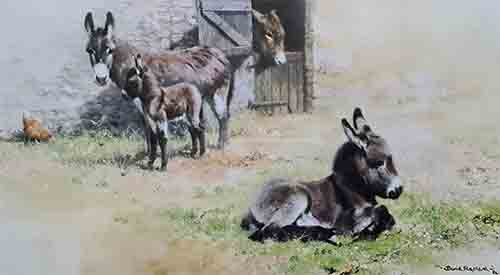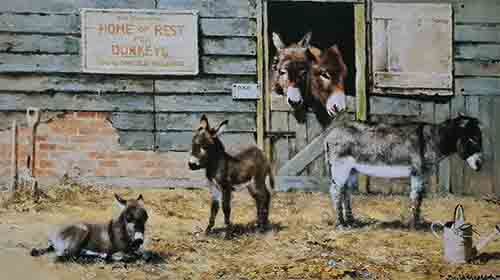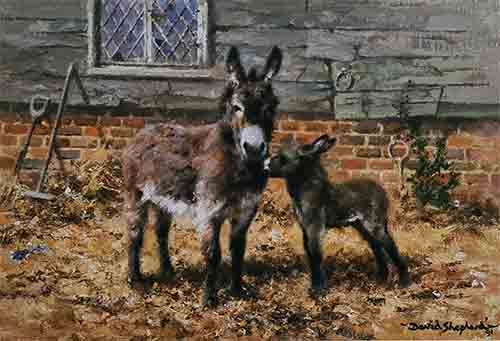Donkeys page
David Shepherd
CBE OBE FRSA FGRAClick on image for details & to ENLARGE
Donkeys hold a significant place in literature, especially in Western cultures. The original representations of donkeys in Western literature come mainly from the Bible and Ancient Greece. Donkeys were represented in a fairly negative form by the Greeks, but perceptions later changed, partially due to donkeys becoming increasingly symbolically connected to Christianity. Donkeys were found in the works of Homer, Aesop and Apuleius, where they were generally portrayed as stupid and stubborn, or servile at best, and generally represented the lower class. They were often contrasted with horses, which were seen as powerful and beautiful. Aesop's The Ass in the Lion's Skin, representational of the almost 20 of his fables that portray donkeys, shows the donkey as a fool. Apuleius's The Golden Ass (160 AD), where the narrator is turned into a donkey, is also notable for its portrayal of donkeys as stubborn, foolish, wicked and lowly. This work had a large influence on the portrayal of donkeys in later cultures, including medieval and renaissance Europe. During this time, donkeys continued to be shown as stupid, clumsy and slow. Shakespeare popularized the use of the word "ass" as an insult meaning stupid or clownish in many of his plays, including Bottom's appearance in A Midsummer Night's Dream (1600). In contrast, a few years later, Cervantes' Don Quixote shows a more positive slant on the donkey, primarily as Sancho Panza's mount, portraying them as steady and loyal companions. This difference is possibly due to donkeys being an important aspect of many Spaniards' lives at this point in time.
In contrast to Grecian works, donkeys were portrayed in Biblical works as symbols of service, suffering, peace and humility. They are also associated with the theme of wisdom in the Old Testament story of Balaam's ass, and are seen in a positive light through the story of Jesus riding into Jerusalem on a donkey. By the 19th century, the donkey was portrayed with more positive attributes by popular authors. William Wordsworth portrayed the donkey as loyal and patient in his 1819 poem Peter Bell:A Tale, using the donkey as a Christian symbol. Robert Louis Stevenson in Travels with a Donkey (1879), portrays the animal as a stubborn beast of burden. Sympathetic portrayals return in Juan Ramon Jimenez's Platero and I. The melancholy Eeyore in Winnie the Pooh (first published in 1926) is arguably the most famous donkey in Western literature.
Donkeys were featured in literature during the 20th century, including in George Orwell's 1951 Animal Farm, where Benjamin the donkey is portrayed as resilient and loyal. Puzzle is a well-meaning but easily manipulated donkey in C. S. Lewis's 1956 The Last Battle. Brighty is the central character of the 1953 children's novel and 1967 film Brighty of the Grand Canyon.[citation needed] Donkeys are portrayed in film including the 1940 Disney film Fantasia, where the donkey is portrayed as a slapstick character who participates in a social faux pas with Bacchus and is punished by Zeus. A donkey is featured as the main figure in the 1966 film Au hasard Balthazar by Robert Bresson, and, is given a life path of Christian symbolism. Donkey, voiced by Eddie Murphy, is featured as a main character in the Shrek films of the 2000s.


